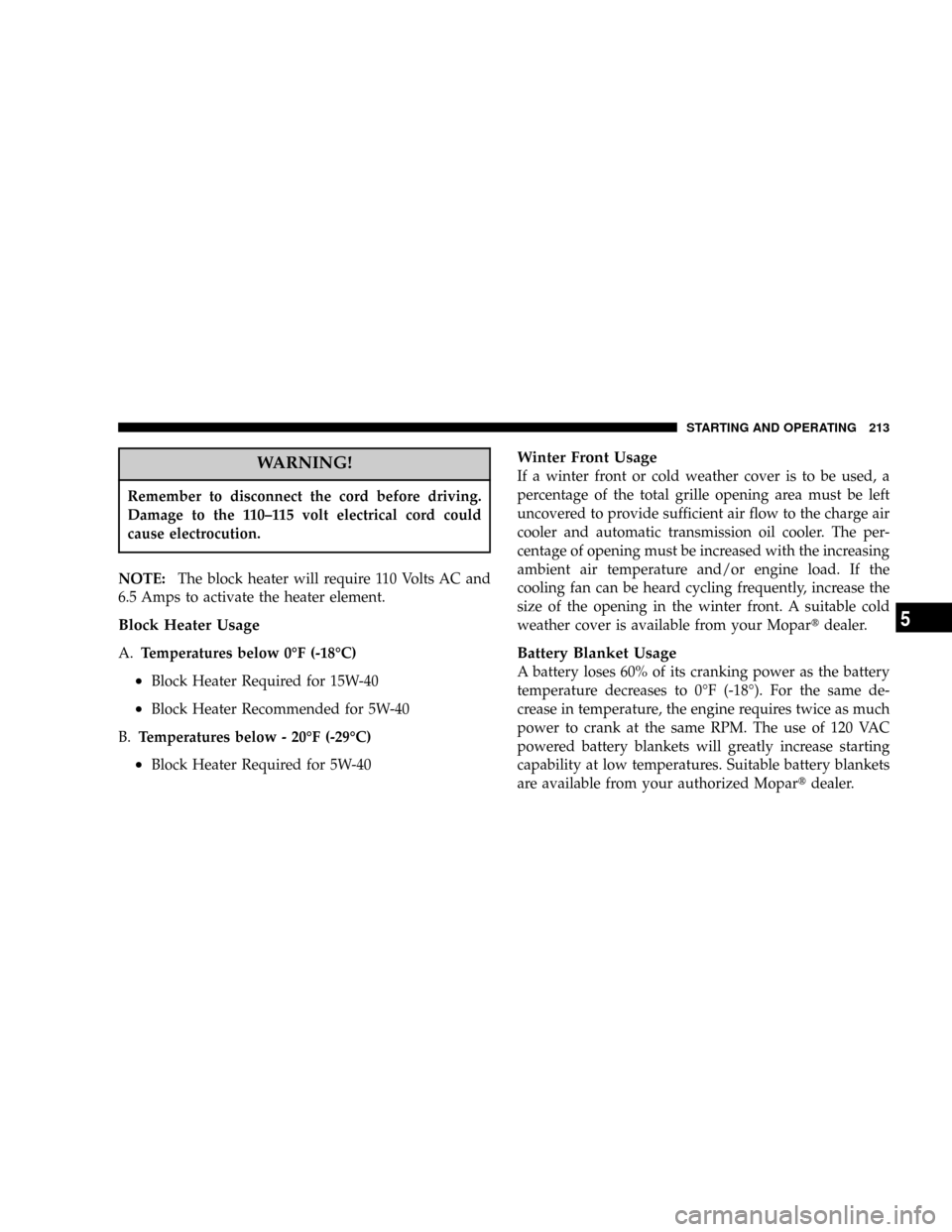Page 144 of 426

2. Voltage Gauge
When the engine is running, the gauge indicates
the electrical system voltage. The pointer should
stay within the normal range if the battery is charged. If
the pointer moves to either extreme left or right and
remains there during normal driving, the electrical sys-
tem should be serviced.
NOTE:If the gauge pointer moves to either extreme of
the gauge, the ªCheck Gagesº indicator will illuminate
and a single chime will sound.
3. Turn Signal Indicators
Lights in instrument cluster flash when outside turn
signals are operating.
4. Tachometer
The tachometer indicates engine speed in revolutions per
minute.CAUTION!
Do not operate the engine with the tachometer
pointer at high rpm for extended periods. Engine
damage may occur.
5. Airbag Indicator Light
The indicator lights and remains lit for 6 to 8 seconds
when the ignition is first turned on. If the light stays on,
flickers or comes on while driving, have the airbag
system checked by an authorized dealer.
6. High Beam Indicator
This indicator shows that headlights are on high
beam.
144 UNDERSTANDING YOUR INSTRUMENT PANEL
Page 145 of 426

7. Seat Belt Reminder Light
When the ignition switch is first turned ON, this
light will turn on for 5 to 8 seconds as a bulb check.
During the bulb check, if the driver's seat belt is
unbuckled, a chime will sound. After the bulb check or
when driving, if the driver seat belt remains unbuckled,
the Seat Belt Warning Light will flash or remain on
continuously. Refer to9Enhanced Driver Seat Belt Re-
minder System (BeltAlertŸ)9in the Occupant Restraints
section for more information.
8. Speedometer
The speedometer shows the vehicle speed in miles per
hour and/or kilometers per hour.
9. Oil Pressure Gauge
The pointer should always indicate some oil pres-
sure when the engine is running. A continuous
high or low reading, under normal driving conditions,
may indicate a lubrication system malfunction. Immedi-
ate service should be obtained.NOTE:If the gauge pointer moves to either extreme of
the gauge, the ªCheck Gagesº indicator will illuminate
and a single chime will sound.
10. Cargo Lamp
The Cargo Lamp light will illuminate when the Cargo
Lamp is activated from the dimmer control switch,
located next to the headlight switch.
11. Door Ajar
The Door Ajar light will illuminate when any
door is opened. When the ignition is ON the
Door Ajar light will stay illuminated until the
open door is closed. When the ignition is OFF
the Door Ajar light will stay illuminated until the open
door is closed or the battery saver feature automatically
turns the light off.
UNDERSTANDING YOUR INSTRUMENT PANEL 145
4
Page 208 of 426

²After the WAIT TO START light goes off, turn the
ignition key to START. Do not press the accelerator
during starting.
²Check to see that there is oil pressure.
²Allow the engine to idle at fast idle for about three
minutes until the manifold heaters have completed
the post-heat cycle.
²Release the parking brake and drive.
NOTE:Engine idle speed will automatically increase to
1000 rpm at low coolant temperatures to improve engine
warm-up.
NOTE:If the engine stalls or if the ignition switch is left
On for more than 2 minutes after the WAIT TO START
light goes out, reset the grid heaters by turning the
ignition switch to Off and the back On. Repeat steps 3
through 7 of the normal starting procedure.
For Extremely Cold Weather Starting (Engine
Temperature Below 0ÉF (- 18ÉC)
In extremely cold weather below 0ÉF (- 18ÉC) it may be
beneficial to cycle the manifold heaters twice before
attempting to start the engine. This can be accomplished
by turning the ignition OFF and then back ON after the
WAIT TO START light has gone off, but before the engine
is started. However, repeated cycling of the manifold
heaters will result in damage to the heater elements or
reduced battery voltage.
NOTE: If multiple pre-heat cycles are used before
starting, additional engine run time may be required to
maintain battery state of charge at a satisfactory level.
²If the engine stalls after the initial start, the ignition
must be turned to the OFF position and then to the ON
position to recycle the manifold heaters.
NOTE:Excessive white smoke and poor engine perfor-
mance will result if manifold heaters are not recycled.
208 STARTING AND OPERATING
Page 213 of 426

WARNING!
Remember to disconnect the cord before driving.
Damage to the 110±115 volt electrical cord could
cause electrocution.
NOTE:The block heater will require 110 Volts AC and
6.5 Amps to activate the heater element.
Block Heater Usage
A.Temperatures below 0ÉF (-18ÉC)
²Block Heater Required for 15W-40
²Block Heater Recommended for 5W-40
B.Temperatures below - 20ÉF (-29ÉC)
²Block Heater Required for 5W-40
Winter Front Usage
If a winter front or cold weather cover is to be used, a
percentage of the total grille opening area must be left
uncovered to provide sufficient air flow to the charge air
cooler and automatic transmission oil cooler. The per-
centage of opening must be increased with the increasing
ambient air temperature and/or engine load. If the
cooling fan can be heard cycling frequently, increase the
size of the opening in the winter front. A suitable cold
weather cover is available from your Mopartdealer.
Battery Blanket Usage
A battery loses 60% of its cranking power as the battery
temperature decreases to 0ÉF (-18É). For the same de-
crease in temperature, the engine requires twice as much
power to crank at the same RPM. The use of 120 VAC
powered battery blankets will greatly increase starting
capability at low temperatures. Suitable battery blankets
are available from your authorized Mopartdealer.
STARTING AND OPERATING 213
5
Page 275 of 426

²Use an approved wiring harness connector on the
trailer. Standard equipment on all RAM pickup mod-
els provides a 4-way trailer tow connector located
under the bumper. This connector contains the follow-
ing vehicle circuits: park/tail lamps, left stop/turn
lamp, right stop/turn lamp, and ground. With the
optional Trailer Tow Prep package a 7-way connector
is provided with the following additional circuits:
backup lamp, trailer battery and electric brake.
NOTE:Connect trailer lighting and brakes using factory
harnesses only. Do not cut or splice wiring to the brake
circuits.
²Be sure the trailer is loaded heavier in front, with 60%
to 65% of the weight in front of the axle(s). Loads
balanced over the wheels or heavier in the rear can
cause the trailer to sway severely side to side which
will cause loss of control of vehicle and trailer. Failureto load trailers heavier in front is the cause of many
trailer accidents. (For a95th Wheel9style trailer, this
range of loading on the9King Pin9should be between
15% and 25%.)
²Make certain that the load is secured in the trailer and
will not shift during travel. When towing cargo such
as livestock, dynamic load shifts can occur that require
the driver to maintain attention.
Trailer Towing Ð Hitches
With a Class I Hitch, your vehicle can be equipped to tow
trailers with a Gross Trailer Weight (GTW) of 2,000 lbs
(907 kg) maximum.
With a Class II Hitch, your vehicle can be equipped to
tow trailers with a Gross Trailer Weight (GTW) of 3,500
lbs (1 587 kg) maximum. Tongue weight must be equal to
at least 10% of GTW, but no more than 15% of GTW.
STARTING AND OPERATING 275
5
Page 276 of 426

With a Class III Hitch, your vehicle can be equipped to
tow trailers with a Gross Trailer Weight (GTW) of 5,000
lbs (2 268 kg) maximum. Factory-installed rear step
bumpers are rated a Class III hitch. Tongue weight must
be equal to at least 10% of the gross trailer weight (GTW),
but no more than 15% of the GTW.
A frame mounted hitch of up to Class IV rating, as rated
by the hitch manufacturer, is supplied as part of the
trailer tow prep package. With a Class IV Hitch, you can
tow a trailer with a Gross Trailer Weight of up to 12,000
lbs (5 443 kg) maximum depending on your vehicle
equipment. Tongue weight must be equal to at least 10%
of the gross trailer weight (GTW), but no more than 15%
of the GTW.Connecting Trailer Lighting And Electric Trailer
Brakes
NOTE:A 4-way trailer tow connector, located behind
the bumper, is standard equipment on all Ram pickup
models. This connector contains the following vehicle
circuits: park/tail lamps, left stop/turn lamp, right stop/
turn lamp, and ground. With the optional Trailer Tow
Prep package a 7-way connector is also provided with the
following additional circuits: backup lamp, trailer battery
and electric brake.
NOTE:There is also a 4±way connector located under
the instrument panel, located to the left of the brake
pedal that is used for the electric brake. This connector
contains the following vehicle circuits; power ground,
battery, stop lamp switch and electric brake feed. The
4±way is optional with the trailer tow prep package.
276 STARTING AND OPERATING
Page 285 of 426

NOTE:During snowplow usage on vehicles equipped
with an overhead console module, the outside tempera-
ture display will show higher temperatures than the
outside ambient temperature. The higher displayed tem-
perature is due to blocked or reduced airflow to the
underhood ambient temperature sensor by the snow-
plow. This is common and outside temperature display
operation will return to normal when the snowplow is
removed.
General Maintenance
Snowplows should be maintained in accordance with the
plow manufacturer's instructions.
Keep all snowplow electrical connections and battery
terminals clean and free of corrosion.
When plowing snow, to avoid transmission and driv-
etrain damage, the following precautions should be ob-
served.
²Operate with transfer case in 4L when plowing small
or congested areas where speeds are not likely to
exceed 15 mph (24 km/h). At higher speeds operate in
4H.
²Vehicles with 48RE transmissions should use 4L range
when plowing deep or heavy snow for extended
periods of time to avoid transmission overheating.
²Do not shift the transmission unless the engine has
returned to idle and wheels have stopped. Make a
practice of stepping on the brake pedal before shifting
the transmission.
STARTING AND OPERATING 285
5
Page 296 of 426
HAZARD WARNING LIGHTS
The Hazard Warning switch is mounted on the top of the
steering column as shown in the illustration.
To engage the Hazard Warning lights, depress the button
on the top of the steering column. When the Hazard
Warning switch is activated, all directional turn signalswill flash off and on to warn oncoming traffic of an
emergency. Push the button a second time to turn off the
flashers.
This is an emergency warning system and should not be
used when the vehicle is in motion. Use it when your
vehicle is disabled and is creating a safety hazard for
other motorists.
When you must leave the vehicle to seek assistance, the
Hazard Warning lights will continue to operate even
though the ignition switch is OFF.
NOTE:With extended use, the Hazard Warning lights
may discharge your battery.
296 WHAT TO DO IN EMERGENCIES